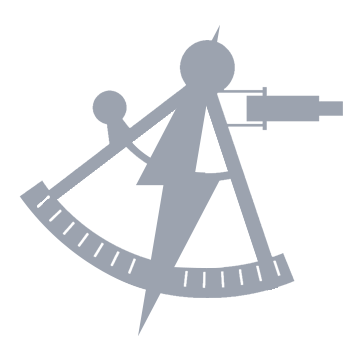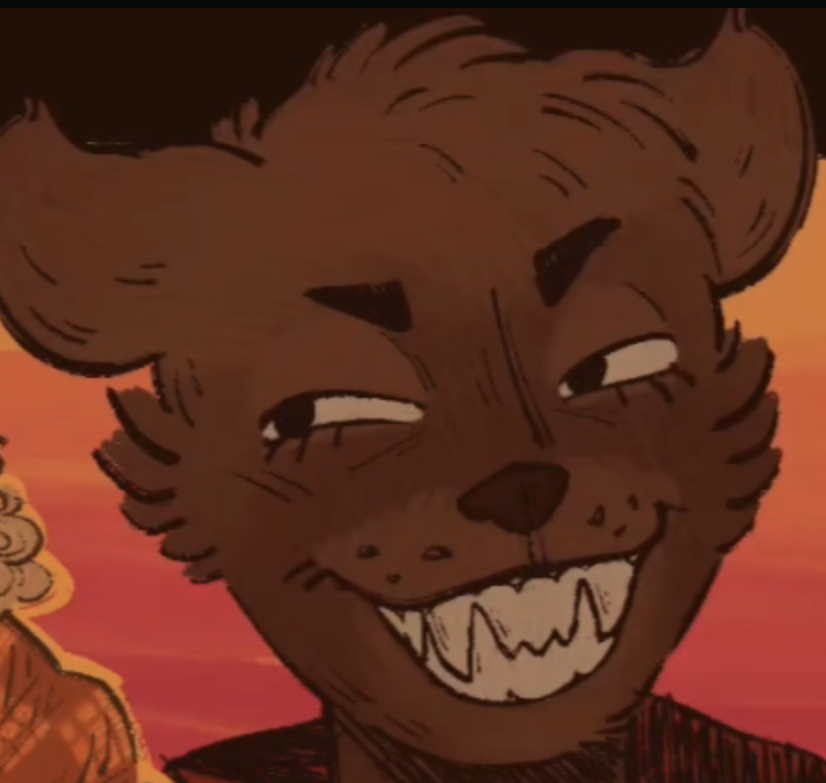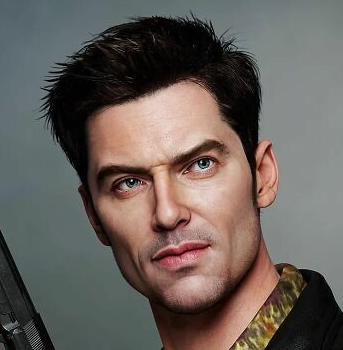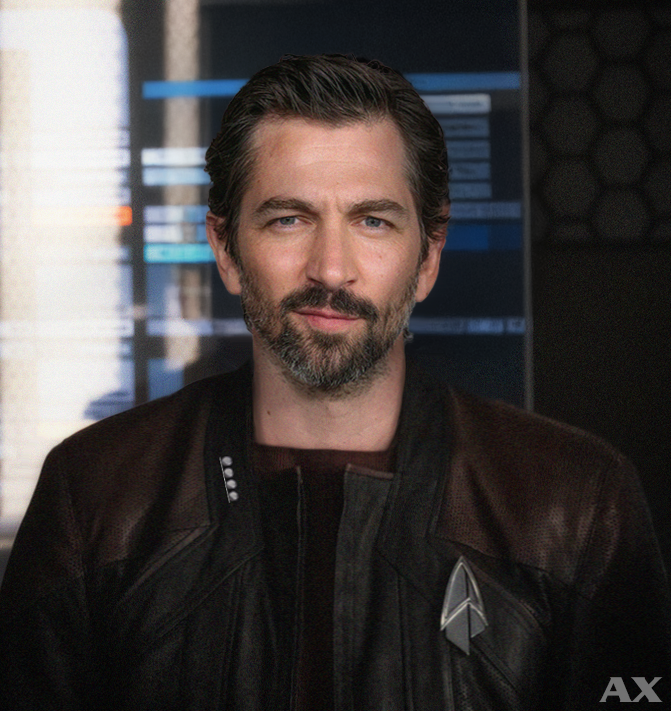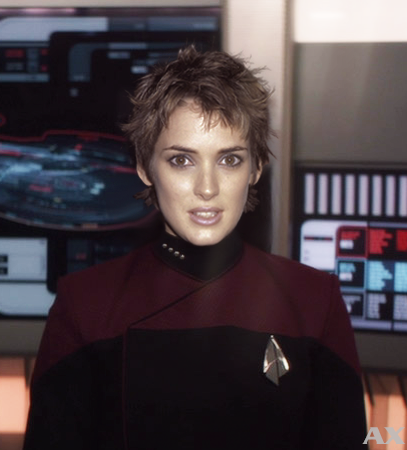The stars out the viewport stretched into lines as the USS Leif Erikson cut through the Shackleton Expanse–a recently discovered, newly accessible area of the Beta Quadrant, on the far side of both the Klingons and the Romulans–towards the Palrilles system, her warp core humming a steady heartbeat through the decks.
In their shared quarters, Lieutenant Junior Grade T’Luni sat neatly on the couch, pouring over her PADD while a movie played in the background on the old CRT screen. Her roommate, Tanna Irovin, sat sprawled on the rest of the couch, holding a cup of hot coffee between her hands, and a look of irresistible excitement on her face.
“You realize,” Tanna said, finally breaking the silence, “We might be the first beings to ever see the Palrilles system.”
T’Luni tilted her head slightly. “Statistically, the likelihood of us being the only ones to observe this region is–”
“Incredibly high.” Tanna interrupted with a grin, “Don’t ruin it, T’Luni. Let me have my moment.”
The Vulcan’s eyebrow arched ever so slightly. “Very well. Proceed with your… moment.”
Tanna laughed and set her mug down on the floor. “You know, T’Luni, I think sometimes you enjoy seeing me get worked up about something.”
“I find emotional expression to be… informative,” she said, setting her PADD down and rising to stand beside the viewport. “Your enthusiasm, however, does not alter the underlying data. The Palrilles system has three planets in the habitable zone. That is sufficient cause for interest.”
“No kidding!” Tanna exclaimed. “You make it sound like it’s just a lab report!”
“I am a scientist,” T’Luni replied evenly.
“We could be looking at entirely new forms of life.” Tanna went on, “Cultures, biospheres, ecosystems. Maybe even pre-warp life that’s never seen a starship before!”
“Discovery for its own sake is a valid scientific pursuit.” T’Luni allowed with a nod. “Although your phrasing implies emotional investment rather than logical curiosity.”
Tanna smiled and winked at her. “I guess that’s why we make such a good team.” She stood and stretched, crossing to her bunk to grab her tunic. “C’mon, let’s celebrate your scientific precision with some breakfast.”
A few minutes later, the pair sat themselves down in a booth in the forward observation lounge, where its panoramic windows revealed the streaming distortion of warp flight. Other officers around them spoke in quiet tones, their conversations peppered with speculation, and the excitement that came whenever Starfleet crossed over into uncharted territory.
Tanna adjusted her plate of scrambled eggs and bacon. “It’s hard to believe we’re this far into the Shackleton Expanse already. I hear the whole Fourth Fleet was mobilized when they found out this region was open for exploration.”
T’Luni stirred a cup of tea. “It is not so remarkable. The Expanse spans nearly one hundred light-years and contains a vast number of star systems. It would make sense for Starfleet to dedicate a whole fleet to explore and chart it.”
Tanna chuckled over her orange juice. “You make it all sound so… boring.”
“Accuracy is rarely dramatic,” T’Luni replied. “However, I will admit that the region presents certain interesting anomalies. For example, the Palrilles System’s star appears slightly younger than its planetary composition would suggest.”
“See?” Tanna said, pointing her fork at her, “You do get excited.”
“I am… attentive.” T’Luni corrected, though a slight lift of her brow betrayed the smallest flicker of satisfaction.
The ship’s motion shifted subtly, a gentle shudder of deceleration that was nearly imperceivable. Out beyond the lounge windows, the streaking stars steadied into fixed points once again.
Then came the familiar chime of the intercom.
“Science Division, report to Lab Two, please,” came the voice of Lieutenant Commander Craig Cruikshank, the Erikson’s Chief Science Officer. His voice was calm, but it carried an unmistakable current of anticipation. “We’ve just arrived at Palrilles System. Let’s see what we’ve got.”
Tanna shot T’Luni a grin. “There it is. Discovery calls.”
T’Luni stood smoothly from her booth. “Then it would be illogical to delay answering.”
Science Lab Two was buzzing with energy and quiet precision. Holographic images and readouts shimmered above the central table, casting a soft blue glow on the glass tabletop and the polished black surfaces of the lab’s consoles.
Lieutenant Commander Cruikshank stood in front of the central display, arms folded over his chest, eyes narrowed as streams of sensor data scrolled upwards. His uniform jacket was unzipped, a clear indication that he was more focused on work than on appearances.
Around him, the science team moved with the disciplined chaos of a team that was used to working together in their element. T’Luni methodically configured sensor harmonics, while Irovin hovered over a geological model, her excitement barely contained.
“Alright,” Cruikshank said at last, finally breaking the buzzing silence, “Let’s get a full spectral analysis on those interior planets. Start with orbital composition, then give me atmospheric readings on anything showing signs of liquid water.”
Lieutenant Junior Grade Irovin’s fingers worked across the console. “Sir, it looks like Palrilles One and Two are both barren – trace iron, carbon dioxide atmosphere, nothing special. Palrilles Three has potential: a thin nitrogen-oxygen mix, a stable orbit, moderate temperature range.” Her voice was steady and even, despite her excitement. This was work, and she loved doing a good job.
The Lieutenant Commander nodded. “Not bad,” he said. “And Four?”
T’Luni spoke up. “Palrilles IV lies just inside the habitable zone’s outer edge. Class M parameters appear probable, though with several notable inconsistencies.”
Cruikshank looked up. “Inconsistencies?’
“The planet’s magnetic field strength is unusually high for a planet of its mass and rate of rotation,” she replied, clasping her hands behind her back. “Additionally, there is a weak but distinct subspace resonance emanating from the lower mantle.”
Irovin leaned over to peek at the display. “Could that indicate tectonic instability?”
“Perhaps,” T’Luni responded, “However, the resonance pattern is… irregular. Almost deliberate.”
The Chief Science Officer frowned. “Deliberate?”
T’Luni met his gaze calmly. “It does not match any known natural phenomena.”
Cruikshank sighed softly, rubbing his stubbled chin. “Alright, let’s not start talking ghost stories quite yet. Run a deeper scan, focusing on subsurface topology and electromagnetic fluctuations. If there’s anything worth seeing, I want to know before we send a probe.”
“Aye, sir,” Irovin said, grinning slightly, “You want to make sure you get first dibs on the good discoveries.”
His mouth lifted slightly in a smirk. “Lieutenant, at my age, I’ve learned to let the data come to me.”
As their scans deepened, the central display showed only Palrilles IV. An ochre-green world, shrouded in mist and streaked with pale mountain ranges. But below the surface, the sensors revealed something else: faint structures of geometrical precision, deep beneath the surface.
“Those aren’t natural,” Irovin said softly.
Cruikshank’s features hardened slightly. “Record everything, we’ll take this to the captain.”
T’Luni adjusted the sensor gain, her brow furrowing slightly. “There appears to be a lattice of voids – large chambers that appear connected. Their layout suggests… design.”
Cruikshank leaned down closer to her console. “Designed by whom?”
No one answered.
The holographic projection rotated slowly in the silence, the planet’s image hanging above the table, secrets buried in the dark beneath its quiet surface.
The Leif Erikson’s briefing room was fairly well appointed – a long curving table facing the panoramic view of the stars. Beyond the windows, Palrilles IV floated in the void, with its muted ochre-green surface streaked with silver clouds muted in the pale light of its star.
Captain Scott Bowman stood at the head of the table, arms folded behind his back. His features reflected faintly in the table’s surface, his eyes fixed on the planet through the viewport. To his left sat Commander Bema Saberwyn, his face and posture rigid, following the words of the Chief Science Officer.
Lieutenant Commander Cruikshank was already halfway through his presentation, gesturing to the rotating holographic model above the center of the table.
“Surface scans show no signs of modern infrastructure, no power signatures, no evidence of active civilization,” he said, “but once we pushed the penetrative scans deeper, we found this.”
The hologram shifted, peeling layers away from the planet in transparent slices, revealing a vast web of empty space beneath the crust. Hundreds of chambers and tunnels formed an intricate lattice that stretched across a continent.
Bowman frowned. “Artificial?”
Cruikshank nodded. “Almost certainly. The geometry is too regular for this to have occurred naturally. Angles and ratios repeating at precise harmonic intervals. If I didn’t know better, sir, I’d say whoever built this had a deep understanding of field resonance – possibly even subspace mechanics.”
Saberwyn leaned forward, speaking for the first time since the meeting began. “Are there any indications of habitation?”
“Not currently. The atmosphere is stable, Class-M, with dense foliage and low levels of radiation, but there are unusual magnetic readings localized around the major cavern systems. It could be ore deposits, or it could be something else.”
T’Luni spoke then, her tone perfectly even. “The subspace resonance detected from orbit appears to emanate from one of the largest subterranean voids. The signal is faint, but consistent.”
Irovin added, eyes bright, “If this structure really is ancient, it’s intact – that’s the remarkable part. There’s no tectonic collapse or thermal degradation. It’s like the planet just… kept it safe somehow.”
Captain Bowman turned away from the viewport. “A preservation effect?”
Cruikshank shrugged his shoulders. “Could be deliberate design, could be luck.”
Bema exhaled slowly through his nose. “And you want to send a team down there.”
“That is what we’re here for, sir.”
Bowman’s eyes lingered on the planet for a moment before he spoke. “Commander, thoughts?”
Saberwyn hesitated, then said, “Unknown structures, irregular subspace resonance, magnetic interference. Every line of that report says ‘caution’. We don’t really know what is down there, or why it was left alone.”
“That’s true,” Bowman agreed quietly, “But Starfleet didn’t send us all the way out here to stare at the sky. We’ll proceed… carefully.”
He turned towards his Chief Science Officer. “You’ll lead the science team. Take T’Luni and Irovin with you, along with an engineering specialist for support. Full environmental suits, independent power sources, and a Type 8 shuttle. I want live sensor feeds to the bridge at all times, and I want you to check in at regular intervals.”
The Lieutenant Commander nodded. “Understood, captain.”
Tanna’s half of their quarters looked like a photon torpedo had gone off.
Uniform components, tricorders, and portable sample kits lay scattered across the bed in organized chaos. The young Lieutenant crouched beside an open equipment case, frowning as she tried to fit one more geological sensor into an already overflowing compartment.
“This would fit,” she muttered, “if this case weren’t designed by a Vulcan who hates joy.”
From the other side of the room, T’Luni raised an eyebrow without looking up from her PADD in her hand. “Your frustration is illogical. The case dimensions are precisely optimal for Starfleet expedition standards.”
Tanna scowled in mock offense. “You would side with the case.”
There was a pause, then the faintest tilt of T’Luni’s head. “It would also fit,” she added mildly, “If you were not attempting to bring your portable DVD player.”
Tanna froze. “You checked my manifest?”
“I reviewed your equipment list to ensure compliance,” T’Luni said, matter-of-factly. “I am uncertain of the scientific purpose of ‘The Princess Bride.’”
“It’s cultural research!” Tanna said, gesturing emphatically. “Also morale support. You’d like it, there’s a Vulcan in it.”
“There is not.”
“Well, there should be.”
T’Luni looked up, and though her expression was as composed as ever, her eyes softened. “You may find that even without your films, the planet itself offers… considerable intrigue.”
Tanna followed her gaze to the viewport. “Yeah, hard to believe no one has ever set foot there.”
“Perhaps they have,” T’Luni said quietly, “And perhaps they have left something behind worth remembering.”
Silence lingered a moment – the kind that carried more anticipation than calm. T’Luni set her PADD down and began closing her own case. “You have packed three tricorders.”
“Backup tricorders,” Tanna said automatically.
“For what purpose?”
“In case the first two break.”
T’Luni considered this a moment, then allowed the faintest hint of a smile. “Your logic is… marginally sound.”
“Ha! Victory,” Tanna said, snapping her case shut.

 Bravo Fleet
Bravo Fleet
